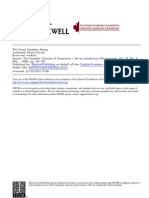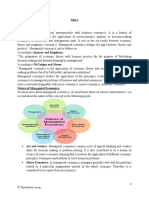Document (2) (9) Macro
Uploaded by
Natnael TesfayeDocument (2) (9) Macro
Uploaded by
Natnael TesfayeMonetary Macroeconomics
Definition: Monetary macroeconomics focuses on the effects of monetary policy on the
economy. It examines how changes in the money supply, interest rates, and other monetary
variables impact economic variables like inflation, output, and employment.
Key Concepts:
Money Supply: Refers to the total amount of money in circulation within an economy.
Interest Rates: The cost of borrowing money or the return on savings.
Inflation: The rate at which the general level of prices for goods and services rises.
Role of Central Banks: Central banks play a crucial role in monetary macroeconomics by
controlling the money supply through tools like open market operations, reserve requirements,
and setting interest rates
Real Business Cycle Macroeconomics
Core Principles: Real business cycle theory posits that fluctuations in economic activity are
primarily driven by real shocks such as changes in technology or productivity. It argues that
business cycles are efficient responses to these shocks rather than due to nominal factors like
monetary policy.
Key Features:
Technology Shocks: Changes in technology can lead to shifts in production possibilities and
drive business cycles.
Labor Market Dynamics: Fluctuations in employment and output are seen as responses to real
shocks rather than nominal factors.
Neo-classical 1870 – 1936.
Neoclassical economics refers to a general approach in economics focusing on
The determination of prices, outputs, and income distributions in markets Through supply and
demand.IT brought the Concept of utility as the key factor in determining value in contrast to the
Classical view that the costs involved in production were value’s determinant.The neoclassical
approach became increasingly mathematical, focusing on Perfect competition and equilibrium
Decisions on economic issues are always made rationally based on Full information on the
usefulness of goods and services
Consumers compare goods and then make the purchase decision Based on the perceived utility
The customer’s main objective is to capitalize on the satisfactionAfforded by the use of the
product
The main aim of the company is to maximize profits
Market equilibrium is achieved only when both the customer and The company achieve their
respective goals
You might also like
- Christopher Leonard: The Lords of Easy Money: How The Federal Reserve50% (4)Christopher Leonard: The Lords of Easy Money: How The Federal Reserve7 pages
- Fortin - 1996 - The Great Canadian SlumpNo ratings yetFortin - 1996 - The Great Canadian Slump28 pages
- Thomas Sowell - Discrimination and Disparities (2018)100% (2)Thomas Sowell - Discrimination and Disparities (2018)369 pages
- (DAILY CALLER OBTAINED) - The State of The Working and Non-Working Man VF100% (1)(DAILY CALLER OBTAINED) - The State of The Working and Non-Working Man VF40 pages
- (Griffin, G Edward) The Creature From Jekyll Island (3rd Ed., 7th Printing, 1998)100% (22)(Griffin, G Edward) The Creature From Jekyll Island (3rd Ed., 7th Printing, 1998)315 pages
- Creature From Jekyll Island, Federal Reserve - BOOK SUMMARY100% (1)Creature From Jekyll Island, Federal Reserve - BOOK SUMMARY10 pages
- One Minute Millionaire by Mark Victor Hansen and Robert G. Allen - Excerpt64% (36)One Minute Millionaire by Mark Victor Hansen and Robert G. Allen - Excerpt27 pages
- Absolute Pure Liquidated Gold For ECO401 FINALSNo ratings yetAbsolute Pure Liquidated Gold For ECO401 FINALS10 pages
- Understanding The Essentials of Microeconomics A Comprehensive Introduction 20240828031535q0ZrNo ratings yetUnderstanding The Essentials of Microeconomics A Comprehensive Introduction 20240828031535q0Zr7 pages
- RMB1E - Managerial Economics - 2 Marks - Dec 2021, May-Dec 2022, May 2023No ratings yetRMB1E - Managerial Economics - 2 Marks - Dec 2021, May-Dec 2022, May 20237 pages
- Economic Assignment: by Jalil Ahmed Roll No 15No ratings yetEconomic Assignment: by Jalil Ahmed Roll No 1528 pages
- Unit-1 Introduction To Managerial EconomicsNo ratings yetUnit-1 Introduction To Managerial Economics13 pages
- Principles of Economics Micro and Macro PerspectivesNo ratings yetPrinciples of Economics Micro and Macro Perspectives9 pages
- Unit-1.2 Diverse field of economics, economic theory, economics models, economic policy and economic systemNo ratings yetUnit-1.2 Diverse field of economics, economic theory, economics models, economic policy and economic system31 pages
- Topic- Scope & Importance of Micro EconomicsNo ratings yetTopic- Scope & Importance of Micro Economics14 pages
- Asset Accumulation and Economic ActivityNo ratings yetAsset Accumulation and Economic Activity5 pages
- Managerial Economics: Economic Way of Thinking:Learning For A ManagerNo ratings yetManagerial Economics: Economic Way of Thinking:Learning For A Manager11 pages
- Market Economies Are Based On Consumers and Their Buying Decisions Rather Than Under Government ControlNo ratings yetMarket Economies Are Based On Consumers and Their Buying Decisions Rather Than Under Government Control1 page
- The 20 Rules of Money - Patrick Bet-DavidNo ratings yetThe 20 Rules of Money - Patrick Bet-David8 pages
- Kindleberger Has Discussed Eight Effects of Tariff On The Imposing Country100% (1)Kindleberger Has Discussed Eight Effects of Tariff On The Imposing Country3 pages
- Economics in One Lesson by Henry Hazlitt - Excerpt14% (261)Economics in One Lesson by Henry Hazlitt - Excerpt18 pages
- Basic Economics A Citizen's Guide To The Economy91% (23)Basic Economics A Citizen's Guide To The Economy379 pages
- The Mystery of Banking, by Murray Rothbard100% (47)The Mystery of Banking, by Murray Rothbard322 pages
- Kathi Weeks, The Problem With Work Feminism, Marxism POSTWORK100% (2)Kathi Weeks, The Problem With Work Feminism, Marxism POSTWORK300 pages
- [Ebooks PDF] download Macroeconomics 22nd Edition Mcconnell Brue Flynn full chapters100% (3)[Ebooks PDF] download Macroeconomics 22nd Edition Mcconnell Brue Flynn full chapters76 pages
- The Creature From Jekyll Island by G. Edward Griffin TextNo ratings yetThe Creature From Jekyll Island by G. Edward Griffin Text315 pages

























































































